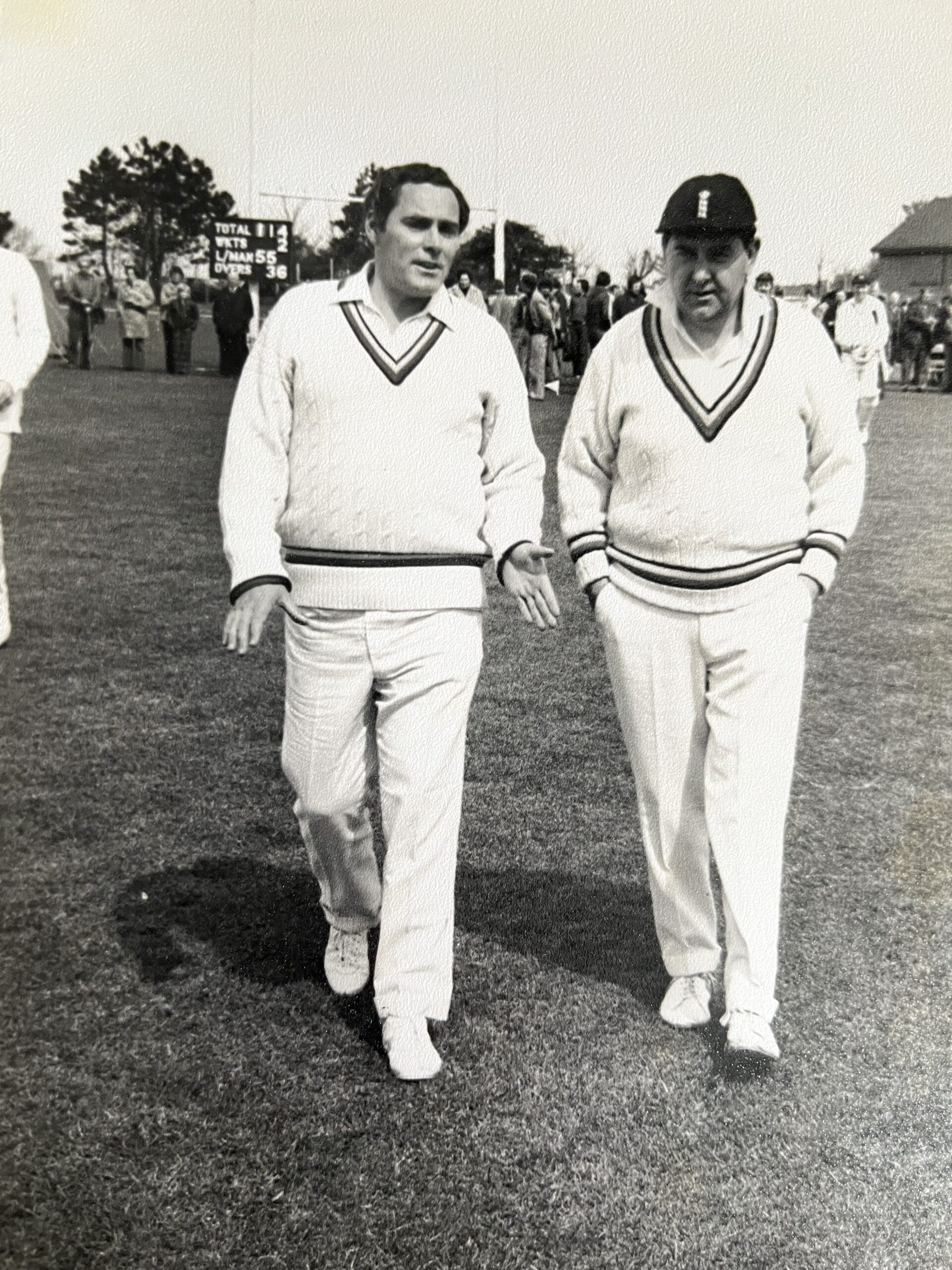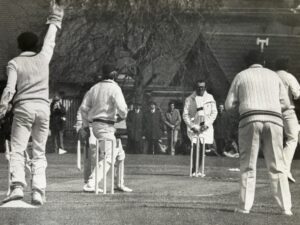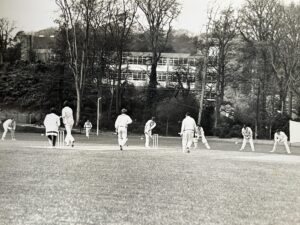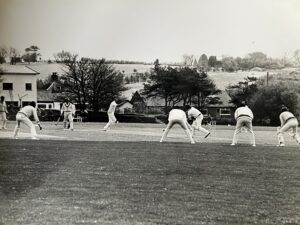An Appreciation of Colin Cowdrey & John Jameson
9 min read
John Jameson and Colin Cowdrey
AN APPRECIATION – by Chris Harte.
Colin Cowdrey
Colin Cowdrey, born in India on Christmas Eve 1932, is a veteran of almost 700 first-class matches. With nearly 43,000 runs he is the tenth greatest run-scorer of all times – these runs including 107 centuries. In Test cricket his record is even more imposing, his 114 caps being a record, as are his 120 catches in the field. Sixty times in his 188 test innings he passed 50 – more even than Garry Sobers who is the only player to have scored more Test runs – 8,032 to Cowdrey’s 7,624.
Educated at Tonbridge School, from whence his eldest son Christopher has recently emerged to the fringes of the Kent XI, Colin Cowdrey made his first-class debut in 1950, and won his Kent cap in 1951, before going up to Oxford. He was three years in the side there, being captain in 1954, 12th man for the England side losing the Oval Test to Pakistan, and gaining selection for the MCC tour to Australia that winter. In that series he made his Test debut, starting with scores of 40, 10, 23, 54 and 102, the last being “out of 160 in 227 minutes” and “preventing a rout”. It was scored at the Melbourne Cricket Ground, at which venue he was often to prosper, and with whose patrons he seemed to establish a particular rapport.
It would be a massive undertaking to review Colin’s career in detail from these encouraging early days right through to his present “semi-retirement”. Playfair last year described him as “still being available in an emergency” and it was in this capacity that England called him to duty in Australia in 1974-5 to face the fires of Thommo and Lillie. Difficult though his task was, he must have found some light relief in the fact that this, a record sixth tour to Australia, was his first NOT AS VICE-CAPTAIN since 1954-55. To have been heir presumptive to May, Dexter, Mike Smith and Illingworth in turn must have required special qualities – those of a stoic perhaps?
Hereafter my selection of events from Colin’s career is entirely arbitrary. I can remember those dark days of early June 1957 when the damage was being done by “Alf” and “Sonny”, the latter in particular. Only the previous summer had I become aware of Test cricket, and that on a diet of magical recalls (Washbrook, Sheppard, Compton and Tyson), Laker and Lock. To find England almost 300 runs behind on first innings against the West Indies (where were the West Indies anyway?) was beyond my eight years. However I shall never forget returning home to find chalked on the message slate – “May and Cowdrey set world record – their 411 for the 4th wicket not only turning defeat into near victory (West Indies 72-7 at the close) but laying the bogey of Ramadhin and Valentine for all-time.
So to 1960 when Colin led England in all 5 tests v South Africa, won all 5 tosses, and the series 3-0. Peter May took over the captaincy again for the last 3 tests the following year against Australia. By 1962 Dexter had a firm grip on the reins, and it was in a match enlivened by Lord Ted’s brilliant first innings 70, among other great events, that perhaps the most celebrated occurrence of an illustrious career took place.
The Lord’s Test of 1963 almost stopped the nation – it certainly postponed the 6 o’clock News. England started the last over needing 8 runs to win with Hall bowling. Shackleton and Allen were at the crease and Colin Cowdrey his left arm in plaster, was padded-up and practising one-handed left-hand stance shots in the dressing-room ready to bat in an emergency (that word again!). On the fourth ball of the over a communications-breakdown saw Worrell outsprint Shackleton to the non-striker’s end. Exit Shackleton, enter the one-arm man.
Allen withstood the last two balls, England got the draw, and M. C. Cowdrey – not out 19 on the scorecard hardly did him justice!
In 1965 Colin Cowdrey enjoyed, statistically, his best-ever season. On 27 occasions he passed 1000 runs in a season, this being only one short of the joint record of W. G. Grace and Frank Woolley. Yet his best in one year was only (??) 2093, average 63.42 – somehow one expected more runs. Yet herein perhaps lies the secret – season after season of high-level performance with quality innings. No real peaks or troughs. The Oval Test of 1965 against South Africa contained two Cowdrey half-centuries, 58 in the first innings and a real gem of 78 not out in the second. This must rank as one of his most memorable knocks. England, one down in the series, were left 399 to win, and had reduced this to 91 in the last seventy minutes when a downpour ended the game. Barber, Russell, Barrington and Parfitt had all contributed valiantly, but it was above all Cowdrey’s innings which brought victory within reach – only for hopes to be washed away together with England v South Africa matches.
1968 saw Cowdrey again captain England at home, this time against the Aussies. In the final test his clever manipulation of the bowlers after another Oval downpour saw England square the series. But the selectors wanted the Ashes and soon Illingworth was in charge. 1971 saw Cowdrey’s last home Test with illness ending his season in early July. And so to the twilight seasons, that emergency call to Australia and 5 Gillette Cup Man-of-the-Match awards a bang on the head from Andy Roberts to ensure that this gentleman of cricket – a C. B. E. since 1972, was never far from the public eye. We welcome him to Bangor, wish him many years of semi-retirement, and look forward to second-generation Cowdreys sporting Kent and England colours.
John Jameson
We devotees of cricket in Ireland have probably suffered more than most from John Jameson’s decision to retire from first-class cricket. Restricted in our view of the top exponents of the game in action to Test Matches (of which he arguably played far too few in an age of English mediocrity) and one-day games (of which he was a natural exponent), the sight of John Jameson striding out to open a Warwickshire innings often delayed a Sunday nap, drive or visit to the garden.
Frequently, and regretably, his innings were short and sweet. I can recall in particular one mini-cameo which terminated in a diving catch on the extra-cover boundary at Canterbury. But what there was in those innings was rich in cricketing taste – the drives were struck with power and a full flow of the bat – the cut was struck not chopped at, the pulls pulled not “helped away”.
John Alexander Jameson was born in Bombay (pedigree for an English captain that!) on 30th June 1941. He made his first-class debut in 1960 and won his county cap four years later. Throughout the late sixties he managed to maintain his regular place in a Warwickshire first six of Abberley, Jameson, Kanhai, Smith, Amiss and Ibadulla. Going into the seventies Jameson’s batting truly flourished, which was just as well for the competition for batting places was now even tighter – John Whitehouse burst on the scene, Kallicharan arrived in the same year (1971), Deryck Murray in ’72, and more recently Geoff Humpage.
Such was the scramble for first team appearances that our own Michael Reith, on a week’s trial with the county in 1972, found himself on the same 2nd XI as Denis Amiss. Jameson rode this storm – in 1970 he scored a career best 1821 runs. In 1971 he improved to 1906 runs and in 1973 to 1948 runs, while 1932 runs the following year was hardly pale by comparison. A less than vintage 1975 did not mark a real decline for he goes out of the first-class game after 1727 runs, average 43.17 including 7 centuries last season, placed immediately above one D. W. Randall in the averages.
Enough of statistics – to do justice to John Jameson the player I will make reference to but a few games in a career of over 350. Early in 1971 Warwickshire paid 2 early season visits to the Parks to play Oxford University. Noted local player Simon Corlett was on the home team (scoring 40 not out and taking 4 for 50 in the first match). In this game Jameson hit 97, while in the second he achieved his career best bowling figures of 4 for 22 (5 for 39 off 16 overs in the match).
In July of the same season the Warwick v India match at Edgbaston must have presaged the first half of John’s extraordinary “2 by 2” test career. This game was a most remarkable one in many ways Warwick 377 for 3 declared in their first innings scored off a mere 80 overs LOST by an innings! Jameson contributed 231 before being Ibw to Bedi at the point of declaration – an effort of only 4 hours 21 minutes and containing as Wisden puts it many “brutal leg-side hits”. He then took 2 for 76 as the Indians piled on 562 all out. One of his wickets was a caught and bowled (little “Vishy’ for 90) and he added 4 other catches in the innings – a feat only equalled that season by one Hamish More of Scotland against Pakistan at Selkirk.
On 5th August 1971, replacing the hamstrung Boycott, John James played his first Test managing 15 and 28 (run out) in a game abandoned due to heavy last day rain with India hopelessly placed. So on to the Oval for an historic game – India’s first Test win on English soil, and end to England’s longest unbeaten Test run (26 games) and John’s highest Test score 82 (run out again). Jameson “recalling the dash of Colin Milburn” (Wisden) batted almost 3 hours. England ran up a first innings lead of 71 only to be routed for 101, India getting home by 4 wickets in an absorbing climax – it certainly stopped me revising for University exams. What of our hero? Here perhaps was the key to the whole game. As Wisden puts it -“After Jameson had been run out for the third successive innings for England – Chandrasekhar deflecting a straight drive from Luckhurst into his stumps – the innings disintegrated”
Not reaching top form in 1972 it required his best-ever season in 1973 to bring him back into contention for a Test place. He was selected for the 1973-74 tour of the West Indies but only managed 325 runs (average 25) in first-class games, though he did score centuries against Bermuda and Guyana ll in other games. The 2nd Test of that series took place at Kingston, Jamaica and was a match to be long remembered for Amiss’ heroic second innings of 262 not out. England, 230 behind on the first innings avoided defeat with Jameson scoring 27 and then 38 batting at No. 3. That 38 was second highest score (apart from 41 extras) and came in a 70-run partnership. This match also featured his only Test bowl and the prized wicket of Clive Lloyd, bowled for 49. 3 and 9 only in the next Test meant he lost his place to Frank Hayes in an English batting order shuffled like a pack of cards. With only one firstclass game of the tour remaining apart from Tests, there was no way back and his tour ended with a 126 and a 53 on the island of Bermuda.
The last phase of Jameson’s career to which I intend to refer in detail ocurred in July 1974 and culminated in his famous world-record stand of 465 unfinished with Rohan Kanhai. In early July Jameson scored 66 and 28 versus Leicester, 88 v Pakistan and 135 & 23 v Lancashire. Then in the Gloucester game Warwickshire “recovered” from 0 for one wicket to 465 for 1 when their 100 allotted overs in the first innings ran out. Jameson finished with 240 and Kanhai with 213 while Gloucester slow left-armer Phil Thorn, an ex-team mate of John Elder at Manchester University finished with first-class cricket after 12 overs, nought for 84! (He did actually play a couple more games).
John Jameson’s career must be described as eventful – this has been merely a sample of his achievements. He has now returned to his Alma Mater, Taunton School, as games Master. Since Playfair records him as playing soccer, rugby and hockey he won’t be lost for winter activity. Neither can one envisage Somerset, avid collectors of others’ premature cast-offs (e.g., Close, Parks, Cartwright) not going to great lengths to encourage, at least, partial activity on the one-day scene for this crowd-pulling player.
C. C. J. H.







